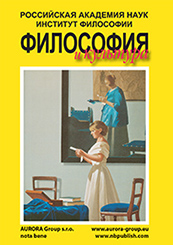Editor-in-Chief's column
Reference:
Gurevich, P. S. (2014). How to Uncover Secrets of Social Dynamics?. Philosophy and Culture, 8, 1087–1091. https://en.nbpublish.com/library_read_article.php?id=65391
Abstract:
Social illusions have been accompanying humans throughout the history of human society. This is not surprising
because social behavior of humans is not ruled by instincts or a biologically established program. Through trial
and error humanity learns different forms of sociality. Noteworthy that trying to achieve happiness, humans are often
drowned in utopia and violence. The English philosopher Karl Popper was right to say that the way to an ideal of happiness
lies through the barbed wire. Meanwhile, we see that social illusions can be very different. There are dreams
that encourage social enthusiasm, spiritual impulses and humanistic hopes. Yet there are social ideas that have a
great destructive power and lead to slavery and death. It is most likely that the positive function of social illusions is to
prevent people from repeating horrors and mistakes that have been known in history. Pavel Gurevich mostly bases his
research on methods obtained from social philosophy. Atthesametime, healso uses what philosophical anthropology
has to offer in human studies. The author also follows the historical analysis principles. The novelty of the article is in
the author’s statement that it is impossible to fully understand the secrets of social dynamics. Forms of human social
life are constantly changing. Science reveals new horizons of human existence. However, the attempt to explain history
by universal laws ‘discovered’ by scientists was severely criticized by social philosophers.
Keywords:
philosophy, history, social philosophy, social illusions, society, social dynamics, historicism, human, utopian thinking, human existence.
Man and mankind
Reference:
Mamedov, N. M., Mansurova, S. E. (2014). The Nature and Essence of Human. Philosophy and Culture, 8, 1092–1103. https://en.nbpublish.com/library_read_article.php?id=65392
Abstract:
The authors of the article analyze meanings and definitions of the terms ‘human nature’ and ‘human essence’
and grounds for their development, generalization and convergence taking into account modern genetic,
anthropological and cultural discoveries. Historically, differentiation of these two concepts was caused by the formation
of the ‘nature and culture’ opposition during the Early Modern Period when it was believed that expansion of
the cultural sphereled to narrowing of the sphere of nature and cultural degradation, on the contrary, resulted in
the revival of nature. The authors of the article show to what degree the aforesaid conclusion can be related to the
human himself and what grounds there are for creating the ‘savage (animal) and civilized human’ opposition. The
article is based on philosophical and general scientific principles of monism and development, integrity and consistency,
concepts of historicism, evolutionism and self-organization. The discovered contradiction between rather conservative
human nature and his free and creative ‘essence’ dictates the discourse about the manageable evolution of
human as an actor of self-development. Philosophical and anthropological terms ‘cultural adaptation’ and ‘cultural
evolution’ are described as a typological factor of human self-development. In fact, the authors describe the path to
creating a new humanism — the goal UNESCO has been actively calling the world community for.
Keywords:
human nature, human essence, generic human, individual, personality, culture, human ecology, post-human history, humanism, trans-humanism.
Philosophy of knowledge
Reference:
Osipov-Gogonenkov, A. S. (2014). Cognitive Intuition and the Problem of Reality (Universal Paradigm Shift in the Cognitive Attitude of the Late 19th —
the First Quarter of the 20th Century). Philosophy and Culture, 8, 1104–1114. https://en.nbpublish.com/library_read_article.php?id=65393
Abstract:
The article is devoted to the analysis of the subject-object cognitive relations that are viewed based on the
example of the artistic image of the window. The metaphor analysis carried out by the researcher allows to describe
the main ideas of the Cartesian dualistic paradigm that were further developed during the period of the development
of social and humanitarian studies in the first half of the 20th century. Therefore, on one hand, the author reveals
the initial problem of the new European subject of knowledge and, on the other hand, outlines the metaphysical aspect
of such subjectivity which allows to speak of certain succession in the development of philosophy from classical
philosophy to modern problems of rationality. In this regard, the researcher believes the ‘anthropological shift’ in the
philosophy of the 20th century to be caused by the ‘epistemological shift’ of the 17th century.
Keywords:
metaphysical grounds of knowledge, non-classical type of rationality, rational validity, contemplative intuition, Cartesian dualism, the window image, metaphor of knowledge, anxiety intuition, subject-centralism, prereflexive reality.
History of ideas and teachings
Reference:
Gaynutdinov, T. R. (2014). The Place of Body Writing in the Structure of Being. Philosophy and Culture, 8, 1115–1120. https://en.nbpublish.com/library_read_article.php?id=65394
Abstract:
Appealing to René Descartes’ works, the author of the article considers the exposition of the body in the
structure of being. Comparing concepts of ‘extension’ and ‘body’, the author sets a goal to analyze the spatial model
of physicality in Cartesianism. Thus spatiality of a body is viewed here ontologically as the ‘extension of the physical
being’. Cartesianism views the physical body as a part of the structure of being and for this reason the body ontology
here is the ‘ontology in the true sense’ as Jean-Luc Nancy noted. Generally following the topological method of the
description of physicality that dominated in Descartes’s texts, the author at the same time combines the topological
method with the phenomenological analysis offered by Merlot Ponty. Indeed, Descartes analyzed the body exclusively
spatially, but it would be incorrect to consider that the space determines the body. It is rather that Cartesianism views
the body as the ‘alienation of space’. This is what Descartes used to develop the concept of the ‘body-machine’, i.e.
the concrete body with particular functions. The author of article also comes to a conclusion that Descartes’s deductive
method originates in anatomic practices. Anatomy studies the ‘body divided into parts’ rather than the body as a
whole allowing a researcher to define the main elements of the general mechanism of the physical body.
Keywords:
René Descartes, Cartesianism, Jean-Luc Nancy, body, ontology, being, space, extension, body-machine, Maurice Merleau-Ponty.
Social philosophy
Reference:
Sizemskaya, I. N. (2014). Modernization and Development of a Civil Society: Russia’s Historical Experience. Philosophy and Culture, 8, 1121–1130. https://en.nbpublish.com/library_read_article.php?id=65395
Abstract:
The article is devoted to the issues of creation and development of a civil society under the conditions of fast
modernization. The author pays attention to the relation between these two processes and believes culture to be the
uniting element between them. When the civil society is missing this element, social tension occurs and modernization
processes slow down. The author of the present article appeals to the historical experience of Russia of the second
half of the 19th — beginning of the 20th century and shows that during that period modernization of the country’s
life style involved economic, institutional and socio-cultural transformations. That provided for a balanced and efficient
modernization on one hand and the development of a civil society according to the pattern that was different
from the European modernization and involved social and cultural factors. Civil society demonstrated itself through
the development of zemstvos (district councils) which realized the self-government principle and self-organization
principle under the control of the government. In parallel the author appeals to the history of the development of
social philosophy of that period and demonstrates how the concepts of the law-governed state that were formed in
the sphere of the Russian liberal thought (philosophy of law) including the concept of the legal socialism introduced
by Kistyakov and Gessen with their idea of extended human rights influenced the practical implementation of modernization
models and the process of the development of the Russian civil society. The author of the article also provides
a full description of the features that defined the nature and directions of interaction in the opposition and consent
with the state authorities. The author also views today’s issues of the development of the civil society and outlines the
‘painful points’ of this process. The author proves that it is necessary to view the aforesaid problems from the point
of view of social philosophy.
Keywords:
modernization, state of law, power, civil society, self-government, culture, responsible freedom, commodity exchange, legal awareness, tolerance.
Philosophy of history
Reference:
Korolev, S. A. (2014). Christianization as a Pseudomorphosis. Philosophy and Culture, 8, 1131–1148. https://en.nbpublish.com/library_read_article.php?id=65396
Abstract:
Within the framework of his concept of pseudomorphic development of Russia, the author of the present
article views the most important and crucial phase of the first Russian pseudomorphosis — adoption of Christianity as the national religion and Christianization of the Old Russia. The author bases himself on the supposition that
Christianization was a pseudomorphic process by nature. The Russian macosociety acquired a socio-cultural ‘cover’
while the cultural content, in particular, paganism, was suppressed and therefore had to develop and survive in those
confines for quite a long period of time. The term ‘pseudomorphosis’ was introduced by Spengler. The author of the
present article views pseudomorphosis as the process imposing a certain cultural cover to macrosociety under which
particular autochthonic contents or certain socio-cultural patterns, practices and life activities have to exist and develop
further (or to exist and degrade). In particular, the author analyzes the phenomenon of the ‘dual faith’. The
author distinguishes the dual faith developed before the Christianization of the Kievan Rus’ that assumed the parallel
development of paganism and Christianity and the dual faith after adoption of Christianity by Vladimir Sviatoslavovich
the Great when paganism existed under the Christian cover imposed on the Russian society. As a component of the
pseudomorphic process the author also views the interaction between the Russian culture of chronicle writing and
spoken pagan mythological tradition. The author notes that a new type of literature, the chronicle, transformed and
deformed the mythological tradition created in pagan oral Russia. The author offers a term “local pseudomorphoses”,
i.e. the pseudomorphoses appearing locally but containing all signs and mechanisms of global pseudomorphoses. As
an example of the local pseudomorphosis the author studies the process of Christianization of pagan ‘foreigners’ in
the Volga region and the Urals in the XVIII-XIX centuries. Finally, the author analyzes a peculiar phenomenon of pseudomorphic
inversion when under the influence of certain circumstances the suppressed autochthonic content revives
and creates a threat to the cultural cover imposed on society. In particular, the author discusses the phenomenon of
Christened Muslims leaving Orthodoxy throughout the XIX century.
Keywords:
pseudomorphosis, culture, Christianization, paganism, dual faith, folk religion, Islam, inversion, chronicles, Russia, Spengler.
Self-consciousness and identity
Reference:
Eltsova, K. K. (2014). ‘Qualitative’ Media for the ‘Educated Minority’: Analysis of the Discourse about Elitism in Russian New Media. Philosophy and Culture, 8, 1149–1175. https://en.nbpublish.com/library_read_article.php?id=65397
Abstract:
The article is devoted to the study of media representations of ‘elitism’ that are provided by the web-based media
as standards. These web-based media position themselves as the mass media addressed to the most educated and
professional layer of the modern Russian society. The author is referring to such projects as Afisha.ru, Bg.ru, Lookatme,
Openspace (2008-2012), W-O-S, Colta, Esquire and Snob. The research is based on ten interviews published by Afisha.
ru and devoted to the changes that have been going on in the media sector (broadly discussed dismissals of editor-inchiefs
and changes in editorial formats) since the start of social protests in Russia in 2011 — 2012. By using the method
of discourse analysis as the main analytical instrument in the research, the author of the present research article is the
first to define and systematize concrete strategies and mechanisms of constructing the images of ‘elitism’ used by the
aforesaid sources. The author also discusses how the studied variant of the elitist discourse combines elements of the
discourse about intellectuality and intelligentsia (with their different variants and modifications) with the idea about the
importance of economic success and associated freedom of consumer choice as the core value of a developed society.
Keywords:
elitism, elite, elitist discourse, discourse-analysis, media representations, social group identity, construction of standards, socio-cultural unity, life style, consumer practices.
The history of humanitarian science
Reference:
Spirova, E. M. (2014). Socio-Cultural Projects of the Image of Human. Philosophy and Culture, 8, 1176–1185. https://en.nbpublish.com/library_read_article.php?id=65398
Abstract:
The article is devoted to the historical and philosophical analysis of the topical issue in the philosophy of culture
— the study of the anthropological dimension of culture. Many cultural philosophers followed Max Scheler’s tradition
who described an impressive number of the images of human discovered in the course of the philosophical and anthropological
expertise. In 1984 a famous French sociologist Albert Jacquard published his book‘Inventer l’homme’ (To Invent
a Human). Albert Jacquard believed that scientific developments allowed to refuse from the traditional model of human
and to create a new human. A similar project was created earlier in 1972. However, it was not about the new technologies
helping to create a new human. The author of the project, Marcel Bolle De Bal, was a professor of the Free University
of Brussels and the author of many articles and books on the philosophy of culture. Marcel Bolle De Bal tried to answer
the question about the image of a European as a result of the cultural evolution the following quarter of the century. The author of the present article uses the historical method allowing to study the main tendencies in the European cultural
development. The author also uses the method of the cultural dynamics analysis. In a number of cases the author also
uses the methods of philosophical anthropology. The novelty of the research is in the question about the anthropological
dimension of the culture taking into account modern approaches to the problem. The article contains a critical analysis
of Marcel Bolle De Bal’s conception and shows the illusions of his approach. According to the author, it was difficult for
the French philosopher to predict what Europe would be like at the end of the 20th century. However, his works contained
very interesting thoughts on the mechanisms of cultural development and possibilities of cultural classification.
Keywords:
culture, human, the image of human, socio-cultural projects, European, society, permanent changes, manipulation, anxiety, prediction.
Religions and religious renaissance
Reference:
Savrey, V. Ya. (2014). The Philosophy of Religion in Origen’s Fourth Book ‘On First Principles’. Philosophy and Culture, 8, 1186–1196. https://en.nbpublish.com/library_read_article.php?id=65399
Abstract:
The author of the article makes an attempt to explicate the theoretical grounds for the philosophical understanding
of religious phenomena by one of the most distinguished philosophers of early Christianity, Origen of
Alexandria. Out of all teachers of the School of Alexandria Origen was mostly discussed and debates over him and his
works lasted for centuries. He was the author of the greatest number of works in ancient literature and his works had a
significant influence on the development of the linguistics of the early Christian theology. One may talk not only about
religious philosophy but also about philosophy of religious of both Origen and the fathers although the term ‘religion’
did not have the same meaning at that time. The author of the present article believes Origen’s fourth book ‘On First
Principles’ to be the most important for philosophy of religion. Based on his interpretation of the world as a parable
and a representation of Logos as the mystery of mysteries, Origen viewed all the historical forms of worshipping God
as a sensual intuition of rationally understood truths. Noteworthy that unorthodox attitude of a philosopher to the
Christian dogma about Resurrection predetermined the ‘dramaturgical’ nature of his vision of religious life in general.
Keywords:
school of Alexandria, On First Principles, Origen, philosophy, religion, hermeneutics, exegetics, Christianity, theology, Bible.
Philosophical anthropology
Reference:
Gurevich, P. S.,Nilogov, A. S. (2014). The ‘Fork’ of Philosophical Anthropology (Conversation of A. Nilogov with P. Gurevich). Philosophy and Culture, 8, 1197–1207. https://en.nbpublish.com/library_read_article.php?id=65400
Abstract:
The conversation of A. Nilogov with P. Gurevich is devoted to the modern trends in Russian philosophical anthropology.
They talk about works written by V. Kutyrev, F. Girenokand other philosophers. Each author maintains his
own definite position in philosophical understanding of human. V. Kutyrev, for example, shows himself as a consistent
critic of innovationism as it was introduced in trans-humanism. V. Kutyrev proves that modern culture demonstrates
the death instinct and this creates a threat for the humanity. F. Girenok holds himself as anarcheo-avantgardist and
offers his own variants of the concepts that have been formed in philosophy and reflect interpretations of human. In
their discussion A. Nilogov and P. Gurevich used the methods of historical analysis allowing to define trends in philosophical
anthropology. They also applied the hermeneutic approach that allows to interpret the current situation in
Russian philosophical anthropology. The novelty of the discussion is that the participants of the discussion tried to understand
current trends in philosophy that are related to human, to discover the main issues of philosophy, to compare
different positions and to clarity the meaning of polemic arguments. A. Nilogov and P. Gurevich noted that the range
of issues under discussion should be expanded and historical fates of Russian philosophy should be discussed as well
as possible influence of philosophy on modern elites.
Keywords:
philosophy, philosophical anthropology, human, death instinct, fiction, ‘death of human’, insanity, transhumanism, technology project, cyborg.
Spiritual and moral search
Reference:
Khrapov, S. A. (2014). Modern Socio-Cultural Environment of the Devaluation of Classical Axiological Models ‘Being’ and ‘God’. Philosophy and Culture, 8, 1208–1215. https://en.nbpublish.com/library_read_article.php?id=65401
Abstract:
The subject under research is the philosophical analysis of modern socio-cultural processes of the devaluation
of axiological models ‘Being’ and ‘God’. Processes of socio-cultural development and axiosocio dynamics are described taking into account their phenomenological and mental grounds. An important part of the research is the
philosophical analysis of philosophical categories ‘Being’ and ‘God’ in terms of broad socio-cultural dynamics and
modern world view crisis. The subject under research can be specified by the names of the following chapters of the article:
The nature of values and the modern socio-cultural crisis; Deaxiologization of the classical image of ‘Being’ and
Deaxiologization of the classical image of ‘God. Research methodology includes the combination of axiological, sociocultural
and social-ontological approaches. The analysis of processes and mechanisms of devaluation of axiological
models ‘Being’ and ‘God’ is carried out by combining philosophical research methods with the categories, concepts
and methods of social psychology and social cognitive science. The scientific novelty of the research is in the discovery
of a number of characteristics of modern socio-cultural dynamics leading to devaluation of classical axiological models
‘Being’ and ‘God’. These characteristics include the ‘spatial and temporal’ gap between culture and sociality when
mechanisms of cultural self-regulation and social memory are left behind the speeding social development which
inevitably distorts processes of socio-gnoseogenic functioning of the public consciousness as the main phenomenon
of the system of socio-cultural regulation; such deformation of the system of traditional values and a long absence of
a new system of values result in a spiritual and ideological vacuum filled with pseudo values and images created for
manipulative purposes; a new system of values is being formed spontaneously, without cultural filtration and by the
means of a metamorphosis combination of the ‘old’ and ‘new’ values; it is not only a simple replacement of values but
a deep structural and phenomenological transformation of axiological grounds of socio-cultural environment; new
axiological grounds include images and representations that are completely opposite to the essence and temporality
of cultural being and human existence.
Keywords:
socio-cultural approach, values, axiological models, axiosociodynamics, Being, God, society, culture, public consciousness, human.
Philosophy and culture
Reference:
Chubarov, I. M. (2014). Creative Writing and Experience of Violence. Philosophy and Culture, 8, 1216–1225. https://en.nbpublish.com/library_read_article.php?id=65402
Abstract:
The article is devoted to the relation between violence and literature. The purpose of creative writing is, if
not to overcome, then at least to define and describe the causes of violence that intertwined with all layers of social
life from economy and politics to visual art and sexuality. Noteworthy that violence is viewed not as an ephemeral
quality that can be controlled and regulated by law, morals, social mechanisms or ideology but as an immanent anthropological
experience or internal quality of social life. The experience of violence determines social life from the
bottom layers to the upper layers, from the violence in images and discursive violence to sexual harassment and using
bodies for economic purposes. Based on the examples from Russian literature, first of all, Lev Tolstoy and Fedor Dostoevsky,
the author of the article compares different theoretical approaches to the relation between creative writing
and violence offered by T. Adorno, Yu. Kristva, V. Podoroga and others. In the article the author uses the method of
the anthropological analysis of literature and art developed in the division of analytical anthropology at Institute of
Philosophy of the Russian Academy of Sciences as well as the textual and comparative analysis of literary writings.
The novelty of the research is in viewing the Russian literature as the anthropological experience of image production
in response to violence and persecution in society. Literature and art interest the author because they are part of the
modern socio-political process they do not only entertain or comfort or please us but also change us and the surrounding
social reality.
Keywords:
disgust, horror, creative writing, violence, Russian literature, art, politics, philosophy, sensuality, left-hand avant-garde.
 This work is licensed under a Creative Commons Attribution-NonCommercial 4.0 International License.
This work is licensed under a Creative Commons Attribution-NonCommercial 4.0 International License.
 Eng
Eng












 © 1998 – 2025 Nota Bene. Publishing Technologies. NB-Media Ltd.
© 1998 – 2025 Nota Bene. Publishing Technologies. NB-Media Ltd.




